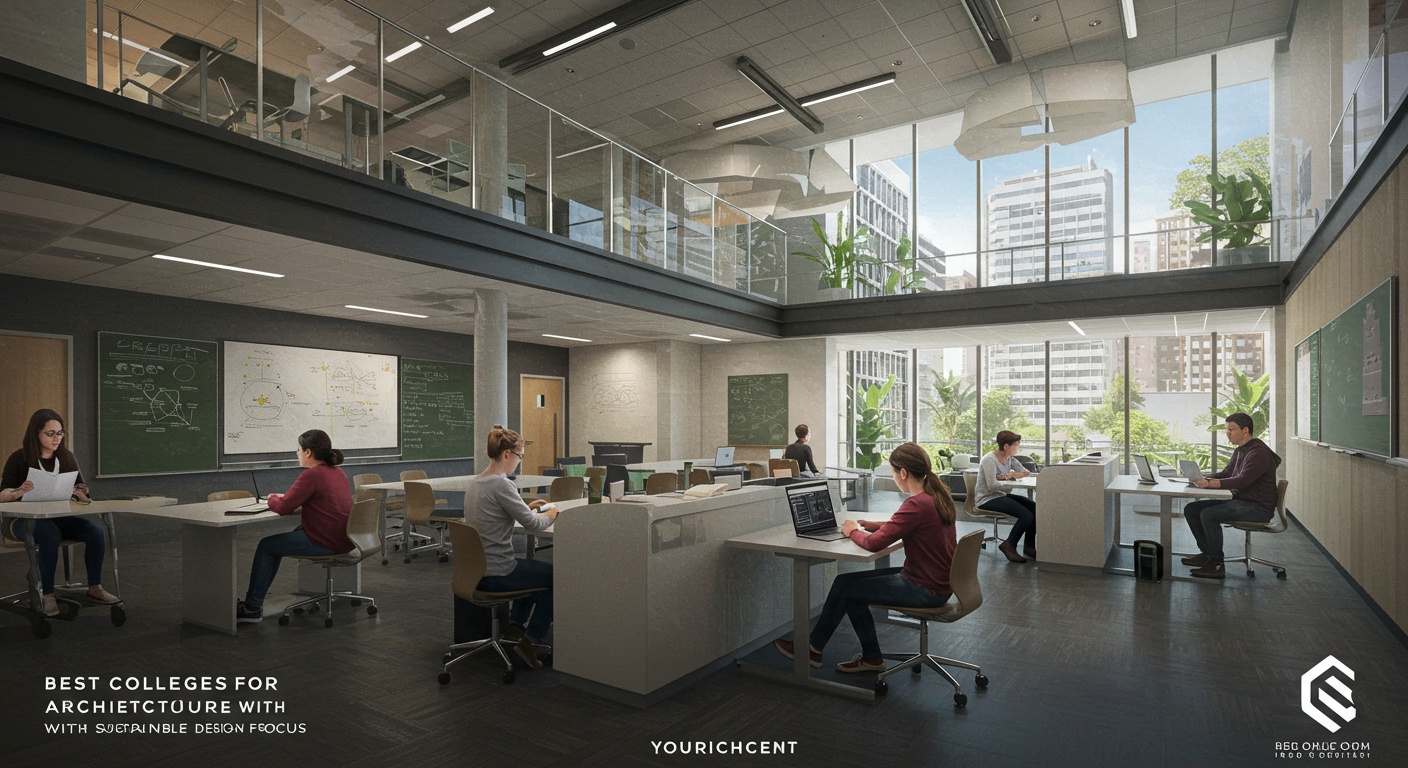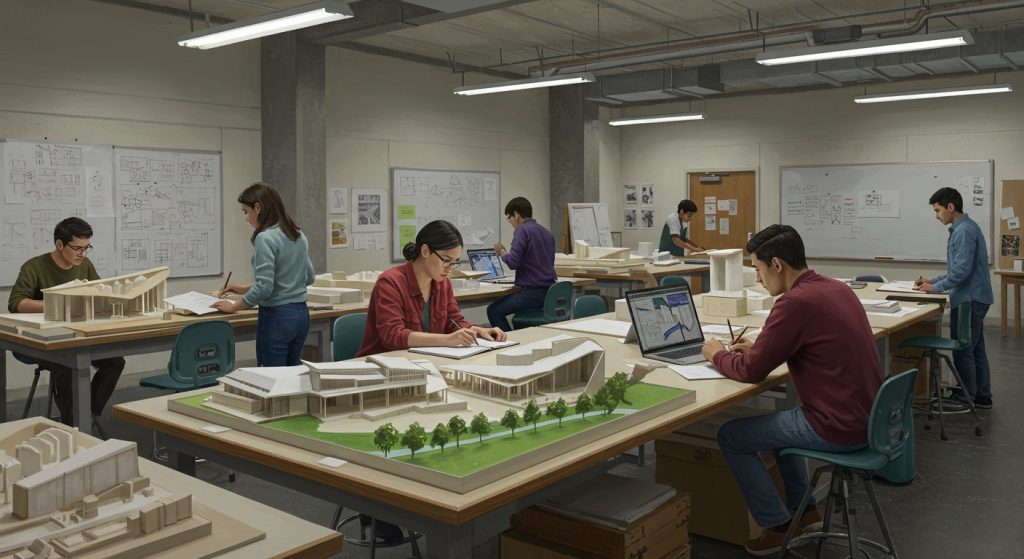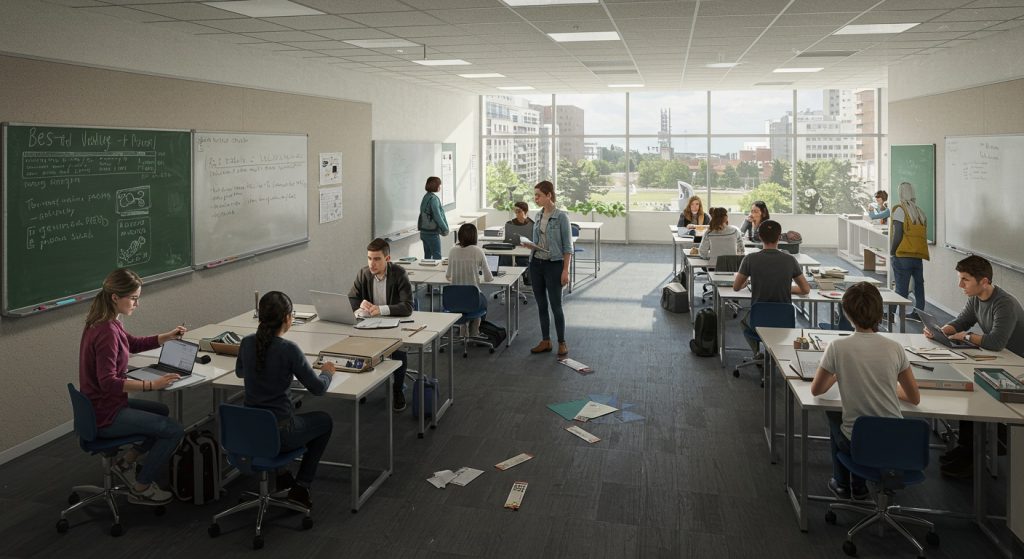Architecture is evolving beyond aesthetics; today’s designs must actively combat climate change. We see a surge in demand for architects skilled in sustainable practices, from passive heating/cooling to incorporating recycled materials. But where do aspiring eco-architects gain this crucial expertise? We spotlight institutions leading the charge, evaluating programs based on studio focus, research opportunities in areas like biomimicry and carbon-neutral construction. Real-world project exposure. Discover schools equipping graduates not just to design buildings. To design a sustainable future.

What is Sustainable Architecture?
Sustainable architecture, also known as green building, is the practice of designing and constructing buildings in a way that minimizes their negative impact on the environment. This involves considering the entire lifecycle of a building, from the extraction of raw materials to its eventual demolition. The goal is to create structures that are energy-efficient, resource-conserving. Healthy for occupants.
Key principles of sustainable Architecture include:
- Energy Efficiency: Reducing energy consumption through passive design strategies (like orientation and shading) and efficient building systems (like high-performance HVAC and lighting).
- Water Conservation: Using water-efficient fixtures and landscaping techniques to minimize water usage.
- Material Selection: Choosing sustainable materials that are recycled, renewable. Locally sourced.
- Indoor Environmental Quality: Creating healthy and comfortable indoor environments with good ventilation, natural light. Low-VOC materials.
- Waste Reduction: Minimizing construction waste and designing for deconstruction and reuse.
Sustainable design goes beyond just the building itself. It also considers the surrounding environment and community. For example, sustainable projects often incorporate green infrastructure, such as green roofs and rain gardens, to manage stormwater runoff and create habitat. They may also be located in walkable, transit-oriented neighborhoods to reduce reliance on cars.
Why Choose a College with a Focus on Sustainable Design?
The field of architecture is rapidly evolving. Sustainability is no longer a niche area but a core competency. Choosing a college with a strong focus on sustainable design offers several advantages:
- Relevance: You’ll gain the knowledge and skills needed to design buildings that meet the demands of a changing world.
- Career Opportunities: Employers are increasingly seeking architects with expertise in sustainable design.
- Impact: You’ll be able to make a positive contribution to the environment and society through your work.
- Innovation: Sustainable design encourages creative problem-solving and innovative thinking.
Many universities are incorporating sustainable design principles into their Architecture programs. But, some colleges stand out for their comprehensive approach, dedicated faculty. State-of-the-art facilities.
Top Colleges for Architecture with a Sustainable Design Focus
Here are some of the top colleges and universities in the United States known for their strong Architecture programs with a focus on sustainability:
Yale School of Architecture (New Haven, CT)
Yale’s Architecture program emphasizes design excellence and social responsibility. The school has a strong commitment to sustainability, with courses and research opportunities focused on energy-efficient design, green building materials. Sustainable urban planning.
Key Features:
- Center for Ecosystems in Architecture: This research center explores innovative approaches to sustainable building design.
- Design-Build Projects: Students have the opportunity to design and construct sustainable buildings in real-world settings.
- Interdisciplinary Collaboration: Yale encourages collaboration between Architecture students and students in other disciplines, such as environmental studies and engineering.
Massachusetts Institute of Technology (MIT) Department of Architecture (Cambridge, MA)
MIT’s Department of Architecture is renowned for its research and innovation in sustainable design. The school’s faculty includes leading experts in energy-efficient building technologies, sustainable materials. Urban resilience.
Key Features:
- Sustainable Design Lab: This lab conducts research on building performance, energy efficiency. Urban sustainability.
- City Design and Development Group: This group focuses on sustainable urban planning and development.
- Building Technology Program: This program offers specialized training in building science and technology.
University of California, Berkeley College of Environmental Design (Berkeley, CA)
UC Berkeley’s College of Environmental Design is a leader in sustainable design education and research. The Architecture program emphasizes environmental stewardship and social equity.
Key Features:
- Center for the Built Environment: This research center focuses on improving the environmental performance of buildings.
- Global Building Innovations Program: This program explores innovative approaches to sustainable building design in developing countries.
- Emphasis on Ecological Design: The curriculum emphasizes the integration of ecological principles into architectural design.
University of Oregon Department of Architecture (Eugene, OR)
The University of Oregon’s Department of Architecture has a long-standing commitment to sustainability. The program emphasizes hands-on learning and community engagement.
Key Features:
- Sustainable City Year Program: This program partners with local communities to address sustainability challenges.
- DesignBridge: This design-build program provides students with the opportunity to design and construct sustainable buildings for underserved communities.
- Focus on Regional Ecology: The curriculum emphasizes the importance of understanding and responding to regional ecological conditions.
Auburn University Rural Studio (Newbern, AL)
While technically a design-build program rather than a traditional Architecture department, Auburn’s Rural Studio deserves mention for its profound impact on sustainable and socially responsible design. Students design and build homes and community buildings in rural Alabama, using locally sourced materials and sustainable construction techniques.
Key Features:
- Design-Build Focus: Students gain hands-on experience in all aspects of the design and construction process.
- Community Engagement: The program is deeply rooted in the local community and addresses the needs of underserved populations.
- Sustainable Materials and Techniques: The Rural Studio emphasizes the use of sustainable materials and construction techniques.
Arizona State University, The Design School (Tempe, AZ)
Arizona State University’s The Design School offers an Architecture program deeply integrated with sustainability principles, particularly relevant in the context of arid climates. Research focuses on resilient design strategies, passive cooling techniques. Efficient resource management.
Key Features:
- Emphasis on Desert Architecture: The program highlights the unique challenges and opportunities of designing in arid environments.
- InnovationSpace: A multidisciplinary environment where students develop and test sustainable design solutions.
- Strong Industry Partnerships: Opportunities to work with local firms specializing in sustainable building practices.
Key Factors to Consider When Choosing a College
When choosing a college for Architecture with a sustainable design focus, consider the following factors:
- Curriculum: Does the program offer courses in sustainable design principles, green building technologies. Environmental science?
- Faculty: Are the faculty members experts in sustainable design? Do they have experience in the field?
- Facilities: Does the school have state-of-the-art facilities for sustainable design research and education?
- Research Opportunities: Are there opportunities to participate in research projects related to sustainable design?
- Location: Is the school located in a region with a strong commitment to sustainability? Does the location offer opportunities to learn about local ecological conditions and sustainable building practices?
- Accreditation: Ensure the program is accredited by the National Architectural Accrediting Board (NAAB).
Technologies and Techniques You’ll Encounter
A focus on sustainable Architecture means learning specific technologies and design techniques. Here are a few examples:
- Building data Modeling (BIM): BIM software allows architects to create detailed 3D models of buildings, assess their performance. Optimize their design for energy efficiency and sustainability.
- Life Cycle Assessment (LCA): LCA is a method for evaluating the environmental impacts of a product or building over its entire lifecycle, from raw material extraction to disposal.
- Passive Design Strategies: These strategies utilize natural elements like sunlight, wind. Vegetation to heat, cool. Ventilate buildings, reducing the need for mechanical systems. Examples include solar orientation, natural ventilation. Shading devices.
- Green Building Rating Systems: Systems like LEED (Leadership in Energy and Environmental Design) provide a framework for designing, constructing. Operating high-performance green buildings.
- Renewable Energy Technologies: Understanding how to integrate renewable energy systems like solar panels, wind turbines. Geothermal energy into building designs is crucial.
Real-World Applications and Use Cases
The principles of sustainable Architecture are being applied in a wide range of projects around the world. Here are a few examples:
- The Bullitt Center (Seattle, WA): This office building is designed to be net-positive energy, meaning it generates more energy than it consumes. It features solar panels, rainwater harvesting. Composting toilets.
- The Crystal (London, UK): This sustainable cities initiative headquarters showcases sustainable technologies and design principles. It features rainwater harvesting, solar panels. A building management system that optimizes energy consumption.
- Passive Houses: These highly energy-efficient buildings use passive design strategies and advanced insulation to minimize energy consumption. They are becoming increasingly popular in Europe and North America.
The Future of Sustainable Architecture
Sustainable Architecture is not just a trend but a fundamental shift in the way we design and build. As climate change and resource scarcity become increasingly pressing challenges, the demand for sustainable buildings will continue to grow. Architects who are trained in sustainable design principles will be well-positioned to lead the way in creating a more sustainable future.
Conclusion
Choosing the right architecture program with a sustainable design focus is a pivotal first step towards shaping a greener future. We’ve explored institutions that not only provide a strong architectural foundation but also deeply integrate sustainable practices into their curriculum. Consider this not just as choosing a school. As choosing a philosophy, a commitment to designing spaces that respect and enhance our environment. As you embark on this journey, remember that true mastery lies beyond textbooks. Seek out internships with firms specializing in sustainable architecture, attend workshops on innovative green technologies like mass timber construction and passive house design. Engage in community projects that address environmental challenges through design. The current trend of biomimicry – drawing inspiration from nature – is particularly exciting and offers endless possibilities for creative and sustainable solutions. Ultimately, your success will be measured not only by the buildings you design but by the positive impact they have on the planet. Embrace the challenge, push the boundaries of conventional design. Become a leader in creating a more sustainable built environment. Remember, every design choice, no matter how small, contributes to a larger vision of a greener future.
More Articles
Top Architecture Schools in Canada with Focus on Sustainable Design
Best Universities for Engineering in Australia
Best Colleges for Civil Engineering with Strong Industry Placements
Top Universities in the UK for Computer Science Research
FAQs
So, I’m really into architecture AND saving the planet. Which colleges are, like, actually good for sustainable design?
That’s awesome! It’s a growing field. Some of the top contenders consistently pop up: places like Yale School of Architecture, Harvard GSD (Graduate School of Design – often a good option even for undergrads planning ahead), University of California Berkeley’s College of Environmental Design. The Architectural Association School of Architecture in London (if you’re up for international!). They all have strong reputations and dedicated programs.
Okay. What makes a school specifically ‘good’ for sustainable architecture? What should I look for beyond just the name?
Great question! Look for schools with faculty who are actively researching and practicing sustainable design. See if they have dedicated sustainable design labs or centers. Check the curriculum – are there courses specifically focusing on things like building performance, material science related to sustainable materials. Renewable energy integration? Also, what kind of hands-on opportunities are available? Projects, competitions. Real-world collaborations are key.
Is it just about solar panels and green roofs? Or is there more to sustainable architecture than that?
Definitely more! While those are crucial elements, sustainable architecture is way broader. It includes things like minimizing environmental impact through the entire building lifecycle (from material extraction to demolition), considering social equity in design, promoting healthy indoor environments. Even thinking about the building’s impact on the surrounding ecosystem. It’s a holistic approach, not just a checklist of green features.
Do I have to go to a super expensive private school to get a good sustainable architecture education?
Not at all! Plenty of excellent public universities offer strong programs. UC Berkeley is a great example. Many state schools have really ramped up their sustainability focus in recent years. Do your research and don’t automatically discount public options – they can offer incredible value.
What about internships? Are there specific types of firms or organizations I should be targeting to get relevant experience?
Absolutely! Look for firms that specialize in sustainable design or have a dedicated sustainability department. Non-profits focused on green building, government agencies working on energy efficiency standards. Even companies developing innovative green building materials are all great options. Networking at conferences and career fairs related to sustainable design can be a goldmine.
I’m worried about the job market after graduation. Is there really demand for architects with a sustainability focus?
Good news! Demand is growing. As awareness of climate change increases and regulations become stricter, the need for architects who grasp sustainable design principles will only continue to rise. It’s a marketable skill set that gives you a real edge in the industry.
What if a school doesn’t explicitly call its program ‘Sustainable Architecture’? Are there other keywords or phrases I should look for?
Totally! Look for programs that emphasize ‘environmental design,’ ‘ecological design,’ ‘high-performance buildings,’ ‘resilient design,’ or ‘integrated design.’ Even if the program title isn’t exactly what you expect, the course descriptions and faculty research interests can tell you a lot.



